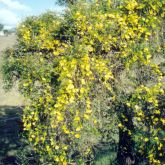Cat's claw creeper

Cat's claw creeper leaf and claws
© Queensland Government

Cat's claw creeper flower
© Queensland Government

Cat's claw creeper infestation on building
© Queensland Government

Cat's claw creeper infestation
© Queensland Government

Cat's claw creeper plant form in flower
© Queensland Government

Cat's claw creeper smothering native vegetation
© Queensland Government
Native to tropical America, cat's claw creeper is an aggressive climber that was once used as an ornamental plant in Queensland gardens. In the wild, cat's claw creeper can smother native vegetation and change soil chemistry. It is now found in many parts of Queensland.
You must manage the impacts of cat's claw creeper on your land.
You must not give away, sell or release cat's claw creeper into the environment.
Scientific name
Other names
- syn. Dolichandra unguis-cati (L.) L.Lohmann
Description
- Large woody vine that climbs and creeps aggressively.
- Flowers are yellow, bell-shaped, 4–10cm long, up to 10cm wide.
- Leaves have 2 leaflets 5–25mm long, with 3-clawed tendril (cat's claw) 3–17mm long growing between them.
- Pods are long, narrow, flat, contain many seeds.
- Fruit is elongated, glossy green when young, dark brown as it matures, 15–50cm long, 8–12mm wide.
- Each fruit contains numerous oblong seeds, 10–40mm long, 4–10mm wide.
- Plant has vigorous root and tuber system.
Habitat
- Prefers warm-temperate, tropical and subtropical areas.
- Can be found in gardens, over fences, along roadsides and waterways, and in disturbed rainforest.
Distribution
- Visit Weeds Australia and click on the distribution tab to access the distribution map.
Life cycle
- Flowers mainly during spring and early summer.
Impacts
Environmental
- Smothers native vegetation, including growing up over trees.
- Changes soil chemistry.
How it is spread
- Spread by water and wind.
- Tuberous roots also spread by floods and humans.
Prevention
Control
Physical control
- Digging tubers out is not practical in most cases.
- Don't allow regrowth to reach host tree's foliage, otherwise you will have to re-cut them.
Herbicide control
Foliar spray
- Treat regrowth with foliar spray.
Cut stump treatment
- Glyphosate 360 mixed at rate of 83mls to each litre of water can be applied in cut-stump method. It is best done in pairs.
- First, cut lead as close to ground as possible and spray/paint chemical on.
- Apply glyphosate within 15 seconds of cutting while sap is running to take poison to roots and tubers. If you miss 15-second mark, cut lower and try again.
- Because of multitude of tubers, herbicide tends to knock tubers down one at a time with new regrowth coming from next tuber. Be prepared to continue control over next 5 years.
Read the Cat's claw creeper fact sheet (PDF, 7.0MB) for herbicide control and application rates.
Biological control
- Currently a target for biological control.
- Tingid bug Carvalhotingis visenda and leaf-tying moth Hypocosmia pyrochroma have been released widely. Field release of leaf-mining jewel beetle Hylaeogena jureceki commenced in September 2012.
- Tingid is widely established in majority of release sites and has caused visible effects in some areas.
- Leaf-mining jewel beetle is target-specific and can severely damage cat's claw creeper.
Legal requirements
- Cat's claw creeper is a category 3 restricted invasive plant under the Biosecurity Act 2014.
- It must not be given away, sold, or released into the environment. Penalties may apply.
- You must take all reasonable and practical measures to minimise the biosecurity risks associated with dealing with cat's claw creeper under your control. This is called a general biosecurity obligation (GBO).
- At a local level, each local government agency must have a biosecurity plan that covers invasive plants in its area. This plan may include actions to be taken on cat's claw creeper. Some of these actions may be required under local laws. Contact your local council for more information.